Eyeing Auriga, Morning Moon Moves over Antares, Splaining Seeing, and Promoting Planet-Views!
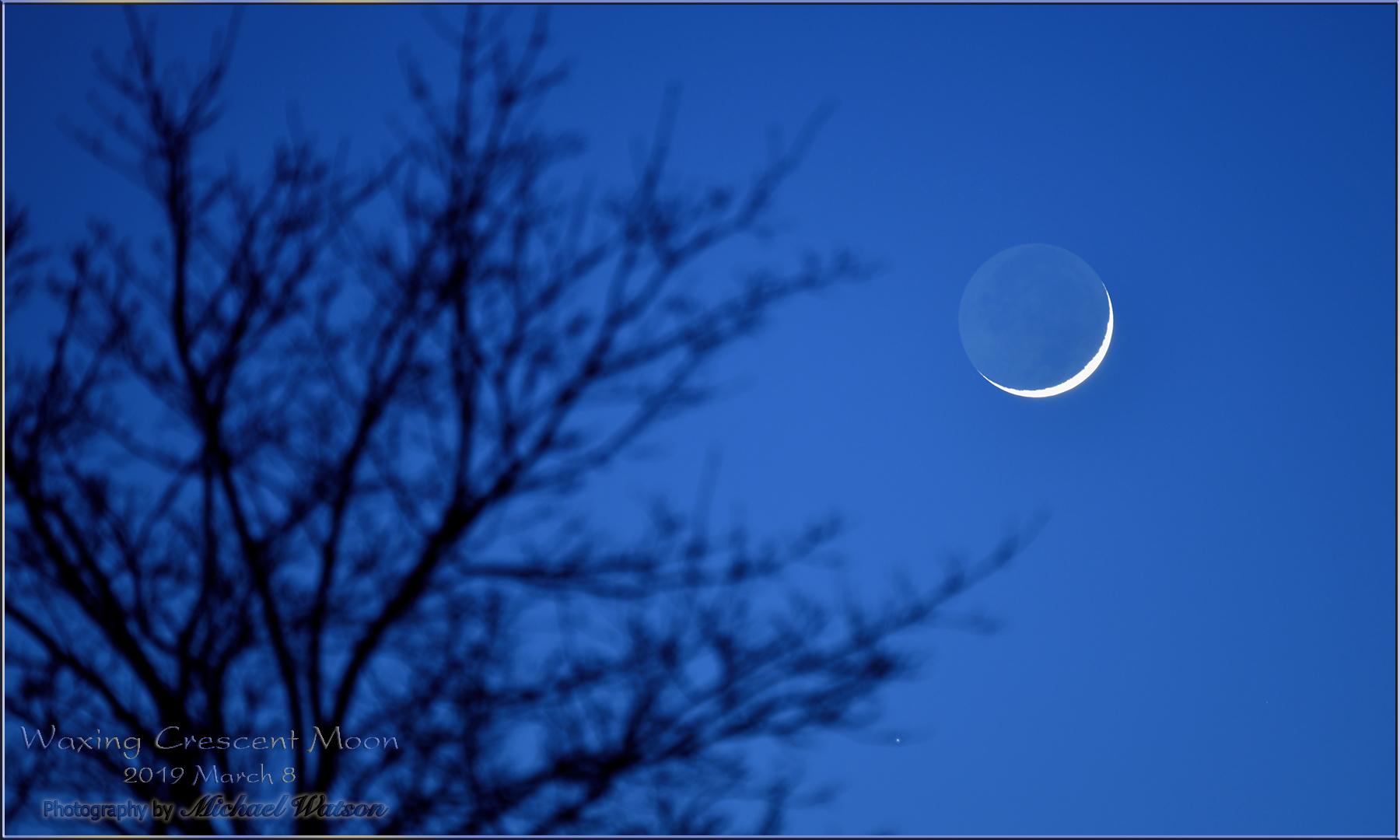
Earthshine on the young crescent moon, captured by Michael watson on March 8, 2019. You can view more of Michael’s images on his Flickr page.
Hello, Winter Stargazers!
Here are your Astronomy Skylights for the week of January 7th, 2024 by Chris Vaughan. Feel free to pass this along to your friends and send me your comments, questions, and suggested topics. You can also follow me on Twitter as @astrogeoguy! Unless otherwise noted, all times are expressed in Eastern Time. To subscribe to these emails please click this MailChimp link.
If you’d like me to bring my Digital Starlab portable inflatable planetarium to your school or other daytime or evening event, or deliver a session online, contact me through AstroGeo.ca, and we’ll tour the Universe, or the Earth’s interior, together! My book with John A. Read entitled 110 Things to See With a Telescope is a guide to viewing the deep sky objects in the Messier List – for both beginners and seasoned astronomers. DM me to order a signed copy!
Before the moon passes its new phase at mid-week, it poses with Venus and maximum-elongated Mercury in the pre-dawn and passes over the bright star Antares on Monday morning. The young moon will return to early evening skies on Saturday. With the moon out of evening until next weekend, we tour the winter constellation Auriga. I explain how sky conditions control telescope-viewing quality and highlight the many shadow and great red spot transits on Jupiter this week. Read on for your Skylights!
The Moon
The moon won’t bother the evening stargazers worldwide this week. It will only appear as a waning crescent before sunrise early in the week and then as a waxing crescent after sunset on the coming weekend. At midweek it will be slipping past the sun.
Monday and Tuesday morning will both offer nice photo opportunities while the pretty crescent of the old moon will pose near Mercury and Venus above the southeastern horizon. For us at mid-northern latitudes, the best time to head out will be around 7 am local time. On Monday morning the moon will also be shining very close to the bright, reddish star Antares in Scorpius (the Scorpion). Telescope-owners in the Americas can see the moon pass in front of (or occult) Antares in daylight between about 9:30 and 10: 40 am Eastern Time. Be careful to keep your optics aimed away from the sun, though. The occultation will happen in a dark sky for folks in the Pacific Time zone, but the moon and Antares will be very low in the sky for them.
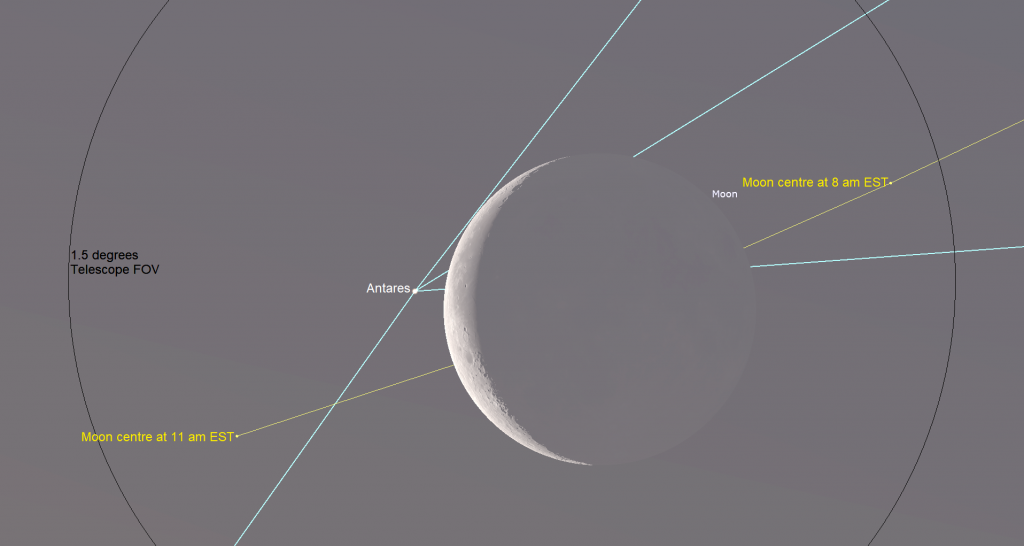
Tuesday morning will offer our last glimpse of the moon before its new moon phase, which will happen on Thursday, January 11 at 6:57 am EST, 3:57 am PST, or 11:57 Greenwich Mean Time. At new, our natural satellite will be located in Sagittarius (the Archer) and 5.8 degrees south of the sun, nearly its farthest excursion south of the ecliptic. (That same excursion gave the full moon some extra elevation two week ago.)
You might catch sight of the young moon’s very slender crescent positioned above the southwestern horizon after sunset on Friday, especially if you live near the tropics. We will all see the moon without difficulty at dusk on Saturday evening, when the yellowish planet Saturn will shine almost a fist’s diameter above it. Watch for earthshine on both Saturday and Sunday evenings. Also called the Ashen Glow or the Old Moon in the New Moon’s Arms, the phenomenon is visible within a day or two of new moon, when sunlight reflected off the Earth and back toward the moon slightly brightens the unlit portion of the moon’s Earth-facing hemisphere. On Sunday evening, the moon’s more fulsome crescent will hop east to shine to Saturn’s upper left (or celestial east).
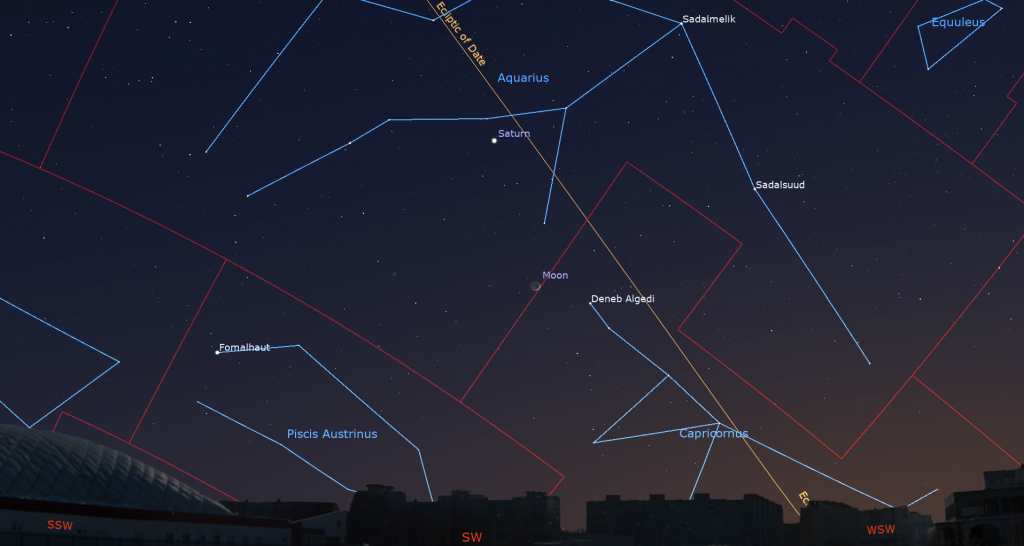
Some Seeing ‘splaining
Bright planets can be seen easily with your unaided eyes when they are more than a few finger widths above a haze-free horizon. But telescope-viewing is best when they are higher than about 15-20 degrees, or 1.5 to 2 fist diameters. That’s because the amount of Earth’s atmosphere that we are viewing celestial objects through dramatically increases the lower you go in the sky. Let’s break that down a bit and then circle back to this week’s planets in the next section.
Everything we see in the night sky is affected by the clarity (cleanliness) and the stability (calmness) of the air that its light has passed through to reach your eyes or optics. If it’s windy outside, the air will be churning. Pockets of higher and lower density will refract and/or scatter the rays of light. Sometimes conditions are calm at ground level, but windy at high elevation. If the air is turbulent, the stars will be twinkling because their extremely narrow rays of light are easily altered by air pockets. Planets tend to twinkle very little because they are much wider than the stars’ pinpoints, so only some of their light beam gets disrupted by the trip through Earth’s atmosphere. If the planets are twinkling then conditions are really bad up there.

The light from an object that is positioned directly overhead in the sky (i.e., at the zenith) is passing through the least amount of Earth’s atmosphere possible for your location. Astronomers define that amount to be one air mass. Light from objects that are lower in the sky must traverse much more air – twice as much (or two air masses) when 30° above the horizon, and five times as much (or five air masses) for objects only 12° above the horizon. The effect peaks at 38 air masses for something on the horizon. The scattering of an object’s light also dims it a little. Astronomers call that extinction.
In a telescope, twinkling shows up as a dynamically warping and/or dancing image for a star and as a general fuzziness or a swimming effect for the moon and planets – as if you are viewing them through the surface of clear, rippling water. Twinkling will always be less for objects that are high in the sky. If I look up and see that even the highest stars are twinkling, I won’t bother setting up my telescope. If you are disappointed with the view through your backyard telescope, just look up and see whether the stars are twinkling. It might just not be a good observing night. (Your optics might also need collimating, but that’s a topic for another day.)
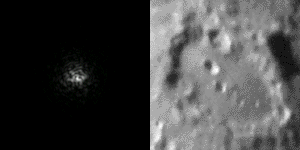
Astronomers use the term seeing to describe the steadiness of the observing conditions. My favourite free astronomy weather forecasting websites and apps, www.cleardarksky.com, www.Astrospheric.com, and www.clearoutside.com all provide hourly predictions for cloud cover, seeing, and transparency.
Transparency in the forecasts tells me the expected clarity of the air. Even clear air will dim (or extinct) an object that’s low in the sky – but add to the sky a bunch of moisture, smoke soot, or plain old dust kicked up by wind, and everything will look fainter. The sky can be free of cloud, or the forecast can say that it’s clear out, but you will not be able to see the fainter stars or your favorite galaxies and nebulae if the transparency is low – so that’s another thing I check when planning my outings. By the way, if you see that airplanes are leaving short contrails then you know that the air is dry.

The air closer to sea level is denser than that at high altitude, so it contributes more to the air mass effect. Astronomers build observatories on mountain tops and elevated plateaus like the Atacama Desert for the thinner, cleaner, and dryer air. And they put them into orbit to avoid the impact of Earth’s atmosphere altogether!
Now you know how I decide whether I’ll drag out my telescope, and why I like to mention how high in the sky the planets are. Speaking of planets…
The Planets
We’ve had a lengthy window for viewing the bright planets during evening, but we’ll enter a bit of planet paucity soon. Due to Earth’s orbital motion around the sun, the stars shift west by four minutes’ worth each night, causing them to rise and set about half an hour earlier with each passing week. The planets do the same thing, more or less.
Saturn and Neptune are already descending the western sky after dusk. If I use 20 degrees elevation or higher in a dark sky as my optimal telescope-viewing cutoff, Saturn will be dropping below that limit after mid-January and Neptune will be getting too low in early February. You’ll be able to see Saturn with eyes, binos, and scopes well into February, but it will be bathed in more and more twilight and appear blurry under magnification. Faint Neptune will vanish sooner.
Even though bright Jupiter sits well east of Saturn on the ecliptic, the later sunsets of springtime will hasten the end of its best telescope-viewing time. By the end of March, Jupiter and nearby Uranus will be dropping below 20 degrees above the western horizon at the end of twilight. They’ll disappear altogether in late April. After that we will hit a planetary dry spell until Saturn starts to rise before midnight again in late July. Venus will become the “evening star” in late August, and Mars, Jupiter, and Uranus will start to put on their show on autumn evenings. All this is to emphasize that you should make planet-observing a priority now, before they are gone! (Don’t worry, we’ll still have Mercury popping up from time to time!)
This week, Saturn’s yellowish dot will pop into view in the lower part of the south-southwestern sky shortly after sunset. The planet will set around 8:45 pm local time. The brightest stars near Saturn will be Deneb Algedi (also known as Delta Capricorni) shining a fist’s diameter to Saturn’s lower right, and the stars Sadalmelik and Sadalsuud positioned a similar distance to Saturn’s right. Those “sadal” stars are two of the “lucky” stars of Aquarius (the Water-Bearer).
Powerful binoculars can hint that Saturn has rings, but any size, style, or brand of telescope will let you see them easily. A better quality of telescope will show them more clearly. Saturn’s brighter moons array themselves above, below, and to either side the planet. Saturn’s largest and brightest moon Titan never wanders more than five times the width of Saturn’s rings from the planet. The much fainter moon named Iapetus can stray up to twelve times the ring width during its 80-day orbit of Saturn. The next brightest moons Rhea, Dione, Tethys, Enceladus, and Mimas all stay within one ring-width of Saturn.

During this week, Titan will migrate counter-clockwise around Saturn, moving from the lower right of Saturn (or celestial west) tonight to above the planet (or celestial northeast) next Sunday night. (Remember that your telescope will probably flip the view around.) The rest of the moons will be tiny specks. You may be surprised at how many of them you can see through your telescope if you look closely.
The faint, blue, ice giant planet Neptune has been following Saturn across the sky every night. On this week’s moonless evenings the magnitude 7.9 planet can be observed through good binoculars and backyard telescopes before about 8:30 pm local time. Search for Neptune above Saturn and about midway between the bright stars Diphda, which marks the aft-end of Cetus (the Whale) and Markab, which occupies the lowest corner of the Great Square of Pegasus.
Neptune will set at about 10:30 pm local time, so plan to look at Neptune as soon as it gets dark. You can also place, Lambda Piscium and Kappa Piscium, the lowest two stars of the circlet of Pisces (the Fishes), just outside the top right edge of your binoculars’ field of view and look for blue Neptune near the bottom left corner of the field. Or, search less than a binoculars’ field width to the right (or celestial west) of the box formed by the four medium-bright stars 27, 29, 30, and 33 Piscium.
Jupiter‘s extremely bright, white dot will gleam in the southeastern sky at dusk and peak telescope-time will arrive around 7 pm. The planet will set in the west by about 2 am. Even binoculars can show you Jupiter’s four largest Galilean moons aligned on both sides of the planet. Named Io, Europa, Ganymede, and Callisto in order of their orbital distance from Jupiter, those moons complete orbits of the planet every 1.7, 3.6, 7.2, and 16.7 days, respectively. If you see fewer than four moons, then one or more of them is crossing in front of or behind Jupiter, or hiding in Jupiter’s dark shadow – or two of the moons are very close together or occulting one another. In the Americas, all four moons will be huddling to Jupiter’s right tonight (Sunday evening). The moons will pair to each side of Jupiter on Wednesday and next Sunday evening.
Any small, decent quality telescope can show you Jupiter’s dark belts and light zones, which are aligned parallel to its equator. With a better grade of optics, Jupiter’s Great Red Spot, a cyclonic storm that has raged for hundreds of years, is visible for several hours when it crosses the planet every 2nd or 3rd night. For observers in the Americas, the GRS will cross Jupiter’s disk in mid-evening Eastern Time tonight (Sunday), on Tuesday, Friday, and next Sunday (with Io’s shadow). It’ll appear late on Thursday night, and also around midnight on Monday, Wednesday and Saturday. The spot has been rather pale pink for some time now. If you have any coloured filters or nebula filters for your telescope, try enhancing the spot with them.
From time to time, the small, round, black shadows cast by Jupiter’s Galilean moons become visible in amateur telescopes when they cross (or transit) the planet’s disk. For those in the Americas, Io’s shadow will cross Jupiter with the red spot on Sunday, January 7 from 4:20 to 6:22 pm EST (or 21:20 to 23:22 GMT). On Friday, January 12 from 11:46 pm to 1:48 am EST, Io’s shadow will cross again. Europa’s shadow will cross Jupiter with the red spot on Saturday, January 13 from 10:13 pm to 12:27 am EST (or 03:13 to 05:27 GMT on Sunday). Io’s shadow will cross Jupiter with the red spot again on Sunday, January 14 from 6:15 to 8:21 pm EST (or 23:15 to 01:21 GMT). (These times may vary by a few minutes, and other time zones of the world will have their own crossings.)
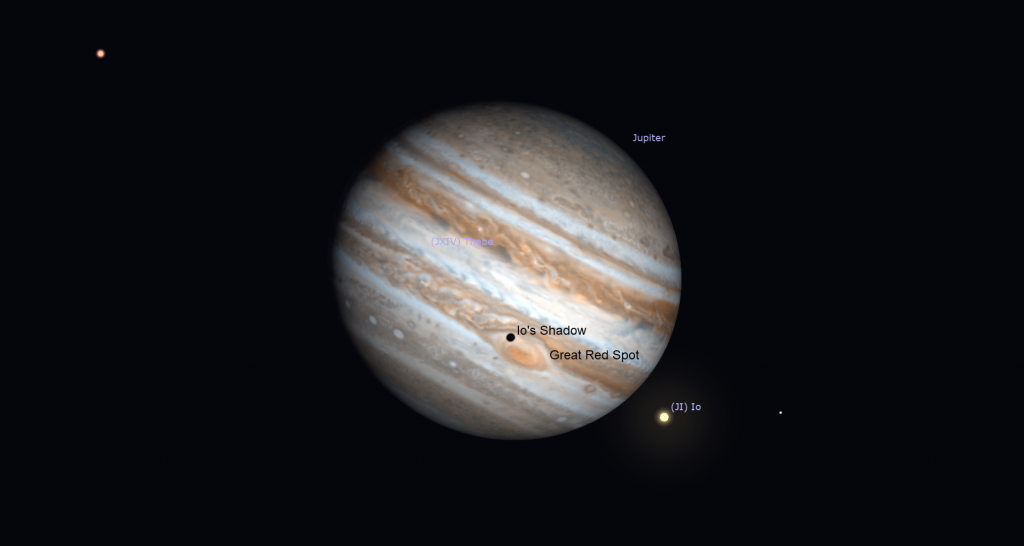
Uranus is following Jupiter across the sky every night and setting around 3:20 am local time. This week the blue-green planet will be positioned 1.3 fist diameters to Jupiter’s left (or 13.3° to its celestial ENE). The bright Pleiades star cluster will be located a generous fist’s width to Uranus’ upper left (or 11.5° to its celestial northeast). Magnitude 5.7 Uranus is normally quite easy to see in binoculars and backyard telescopes under moonless conditions. Some people have even been able to spot the planet with their unaided eyes. Use binoculars to find the medium-bright star Botein between Jupiter and the Pleiades. The blue-green speck of Uranus will appear several finger widths to its lower right.
Have you wanted to see an asteroid? The large, main belt asteroid named (4) Vesta will be passing the medium-bight star Zeta Tauri (aka Tianguan), the lower horn tip star of Taurus (the Bull) this week. At magnitude 6.4, Vesta is brighter than Neptune and almost as bright as Uranus. Tonight (Sunday) it will be located just to the left of the star. On each subsequent night it will shift more to the star’s upper right and move telescope-close to the Crab Nebula or Messier 1 later this week.
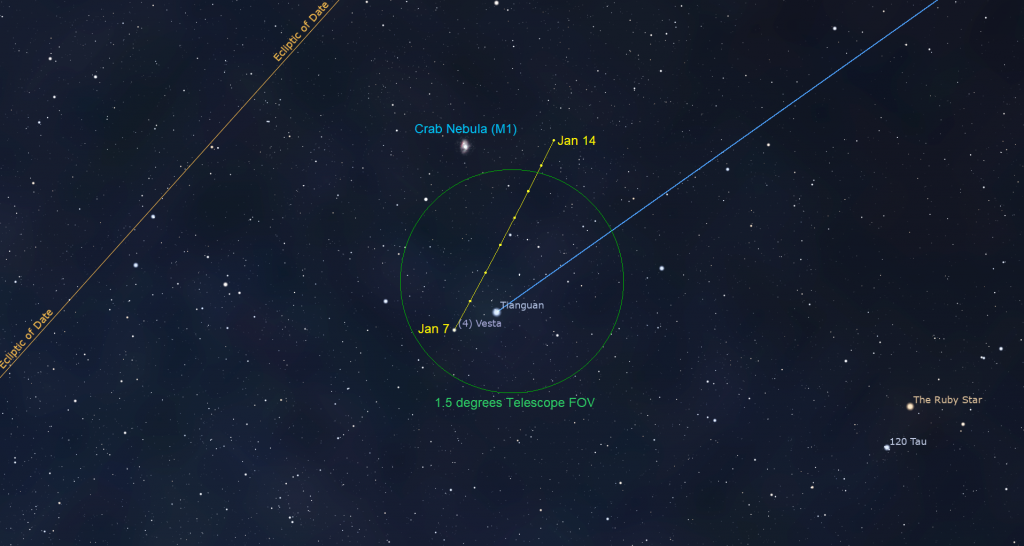
As I mentioned above, the pretty crescent moon will shine in the southeastern sky with brilliant Venus and fainter Mercury on Monday and Tuesday morning before dawn. This week, after it rises around 5 am local time, Venus will continue is daily descent through the morning stars of southern Ophiuchus (the Serpent-Bearer). Like Saturn, we only have about one more month to view Venus during this apparition. If you head out for a look before the sky brightens on a few mornings this week, you can detect Venus’ motion compared to the bright star Antares to the lower right of it. Viewed through a telescope this week, our next-door planet will show a shrinking, waxing gibbous disk spanning 14 arc-seconds.
Mercury will spend all of January visible in the pre-dawn eastern sky – with far brighter Venus gleaming to its upper right (or celestial west). This week, the medium-bright, magnitude -0.23 planet will rise around 6 am local time. On Friday, Mercury will reach its widest angle of 23.5° west of the sun, and peak visibility for its current morning apparition. Starting around 6:30 am in your local time zone, look for the planet shining very low in the southeastern sky, and climbing. It will be positioned 1.2 fist diameters to the lower left of much brighter Venus. In a telescope Mercury will exhibit a 63%-illuminated, waxing gibbous phase. Mercury’s position above the shallowly-dipping morning ecliptic will make this a good apparition anywhere on Earth, and an excellent showing for those located near the Equator. The planet will continue to be well-placed for viewing during the week after greatest elongation. For eye safety, turn all optics away from the eastern horizon before the sun rises.
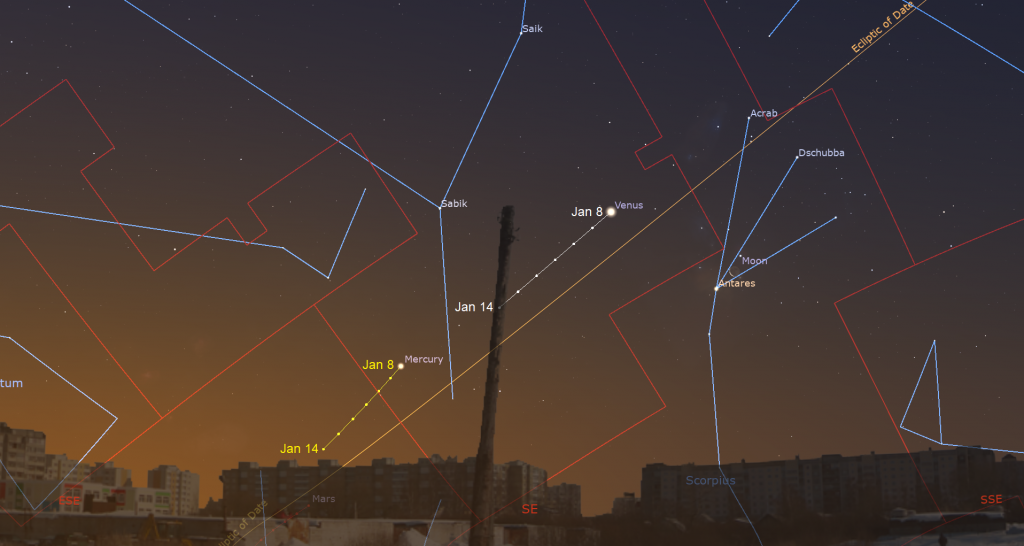
Mars, which is approaching Mercury from below, will become visible before sunrise next month.
Auriga Drives the Chariot
Winter evenings at mid-northern latitudes sparkle with the bright, hydrogen-fusing diamonds forming the constellations of Taurus (the Bull), Orion (the Hunter), Auriga (the Charioteer), and Gemini (the Twins). I posted my in-depth tour of Taurus, including star charts and some images of the best objects, here. This week we’ll ponder the best sights to see in Auriga (the Charioteer). In future Skylights, we’ll tour Orion and Gemini.
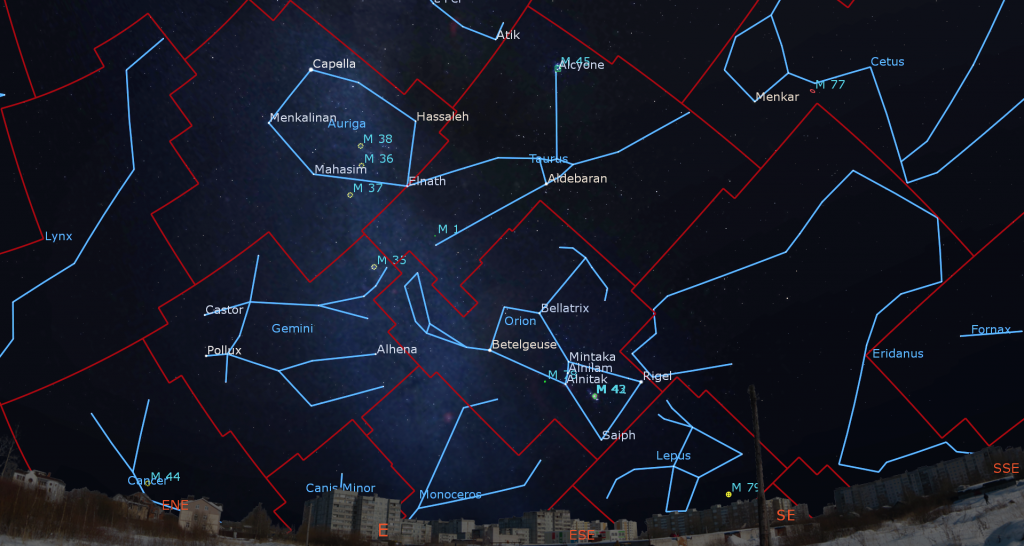
Auriga is one of the original 48 constellations that the Greek astronomer Ptolemy recorded in his Almagest, which was published around 150 AD. Because the constellation is centred nearly 40 degrees north of the celestial equator, it is not visible at all from mid-southern latitudes, remains close to the northern horizon for observers at equatorial latitudes, and is circumpolar for much of Canada and other northerly latitudes.
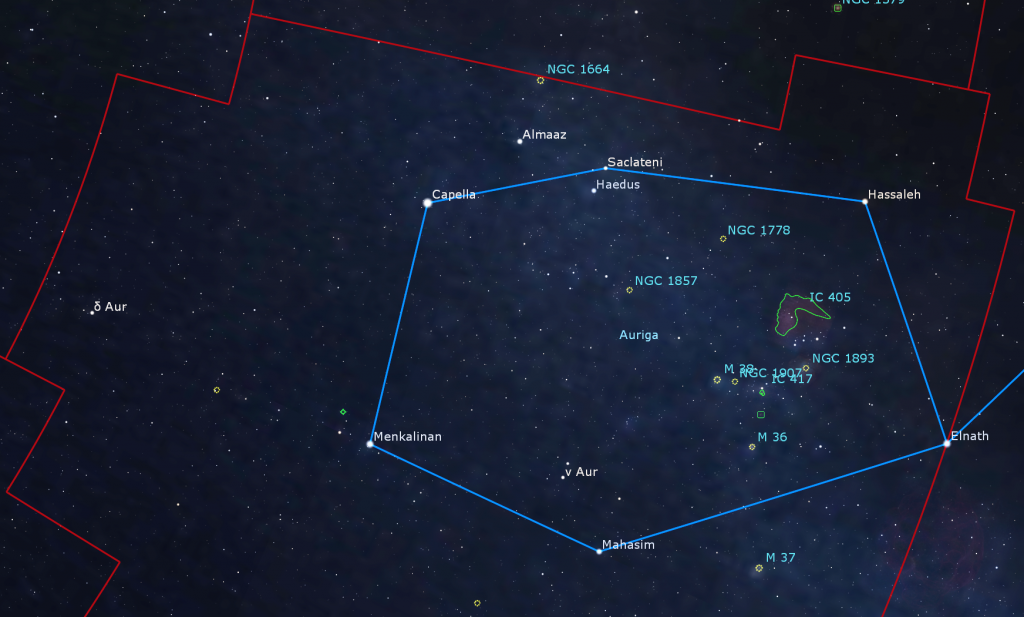
Auriga’s brightest stars form an elliptical shape measuring about two fist diameters (17 degrees) north-south by about one fist diameter (12 degrees) east-west, with the very bright star Capella near its northern end. Auriga’s southernmost bright star is shared with Taurus (the Bull), marking that critter’s northern horn tip. The official International Astronomical Union (IAU) boundary of the constellation spans 28 by 36 degrees of the sky. Perseus (the Hero) borders Auriga on the west (to the right for Northern Hemisphere observers). The twins of Gemini are on Auriga’s eastern boundary – sharing it with the dim constellation Lynx above them. The lesser-known, dim constellation of Camelopardalis (the Giraffe) occupies the sky to Auriga’s north.
The charioteer has been depicted in several ways over the years. It seems logical that the large, boxy ring of stars represents the chariot, and Capella represents the driver. Three medium-bright stars form a narrow triangle just south of Capella. Nick-named the Kids, they are said to represent an adult goat on his shoulder, and two kids under his left (western) hand. His right (eastern) hand holds the reins. In other stories, Capella is the adult goat and the three stars are her kids. The goat motif may have arisen before Ptolemy when the Mesopotamians saw the main stars of Auriga as a curved shepherd’s crook tending the little flock of stars.

In Greek mythology, several stories have been linked to Auriga. He was the Greek hero Erichthonius of Athens, who was the son of Hephaestus, and was raised by the goddess Athena. Erichthonius invented the four-horse chariot, created in the image of the Sun’s chariot, which he used in battle to become the king of Athens. Zeus raised him into the night sky in honor of his ingenuity and heroic deeds. He may also have been Hermes’s son Myrtilus or Theseus’s son Hippolytus, both well-known charioteers – or Bellerophon, the original rider of Pegasus.
In early evening during January, Auriga is halfway up the eastern sky, with Capella at the top left of the ring. By 11 pm local time, the constellation will ascend to the zenith – the best time to view its deep sky treasures. (More on those below.) Note that Auriga is visible during much of the year in Canada – but its rotation around the North Celestial Pole means that its orientation varies a lot.
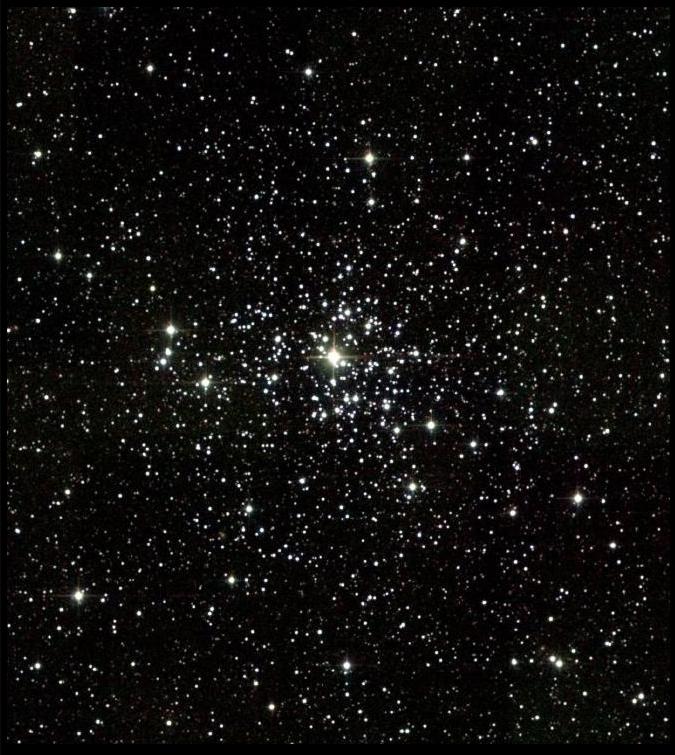
Capella (Latin for “she-goat”), which marks the charioteer’s left shoulder, is the 6th brightest star in the entire night sky. At 42 light-years from Earth, Capella is a multi-star system. Its brightest components are yellow G-class stars similar in temperature to our sun, but larger and brighter. Let’s tour the rest of Auriga’s main stars, moving clockwise from Capella.
Three finger widths to the right of Capella sits the magnitude 3 star Almaaz “the he-goat”. Almaaz is a distant and hot F-class star that emits nearly 47,000 times as much energy as the sun. It’s also an eclipsing binary system that dims by 1.0 magnitudes for a two-year interval every 27.1 years – perhaps because of a giant dust ring orbiting the star?! The other two Kid stars are Haedus I and II, or Zeta and Eta Aurigae. The lower (eastern) star is 200 light-years away, and the other star is 850 light-years distant.
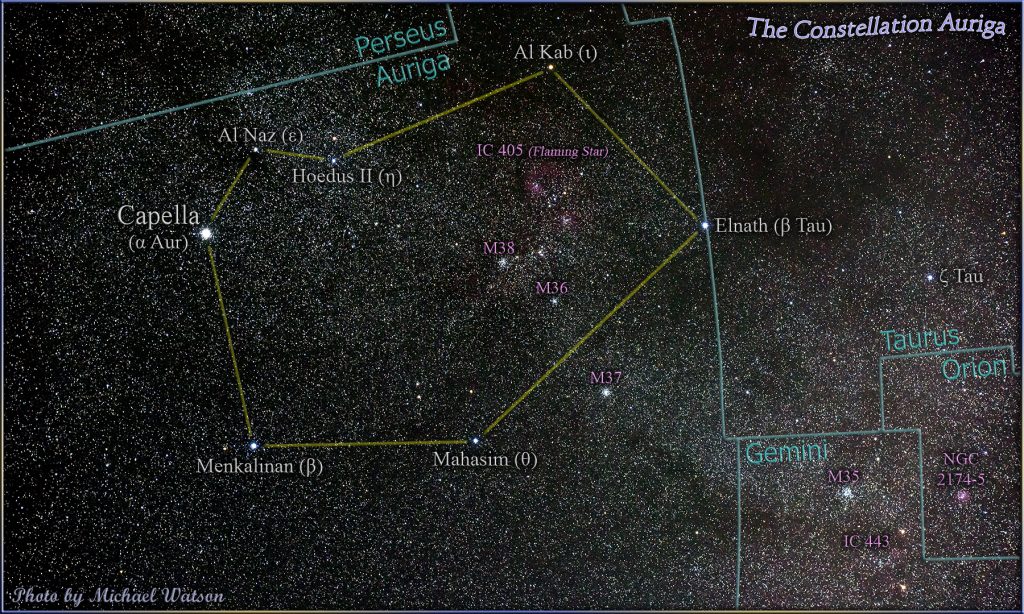
Jumping 1.3 fist diameters to the right (or 13 degrees south), past the Kids, the next medium-bright star we arrive at is Al Kab or Hassaleh “the shoulder of the reins-holder”. This orange K-class giant star is more luminous than it looks because interstellar dust is dimming it. A palm’s width below Al Kab is bright Elnath, the northern horn star of Taurus.
From Elnath, swing a fist’s diameter back to the left (celestial north) to Theta Aurigae. Theta is a hot A-class star located 173 light-years from us. An intense magnetic field around this star has herded elements like silicon and chromium into patches that appear and disappear as the star rotates every 3.61 days.
Our trip around Auriga’s ring ends with Menkalinan (“the shoulder of the reins-holder”). It’s also known as Beta Aurigae. This star resembles Sirius and Vega – but its greater distance from us (82 light-years) dims its apparent brightness compared to those beacons.
A medium-bright, magnitude 3.7 star named Delta Aurigae sits a fist’s diameter to the left (north) of Menkalinan and Capella. Some star charts show it as the pointed end of the chariot – or the driver’s hat. A line extended from Theta through Menkalinan and Delta points almost exactly at the true North Celestial Pole!
The outer rim of our Milky Way passes through Auriga – filling the right-hand (or southern) half of the ring with star clusters and nebulas. Several clusters are very obvious if you scan the constellation with binoculars from a dark location. Forming a large triangle midway between Al Kab and Theta, you’ll find the bright open star clusters Messier 38 to the left and NGC 1893 sitting three finger widths to the right – with Messier 36 below and between them. Two finger widths below the line connecting Elnath to Theta is the bright cluster Messier 37. There are several more clusters and nebulae to discover in Auriga.

Public Astronomy-Themed Events
Every Monday evening, York University’s Allan I. Carswell Observatory runs an online star party – broadcasting views from four telescopes/cameras, answering viewer questions, and taking requests! Details are here. They host in-person viewing on the first clear Wednesday night each month. Other Wednesdays they stream views online via the observatory YouTube channel. Details are here.
Keep your eyes on the skies! I love getting questions and requests. Send me some!